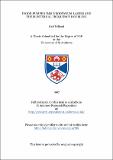Diode-pumped IμM neodymium lasers and their internal frequency doubling
Abstract
In this thesis the design, construction and performance of several diode-laser pumped continuous-wave neodymium lasers are described. These lasers were operated both around 1 mum and, by internal frequency-doubling, at 0.5 mum. The main emphasis has been on the assessment of the various laser designs with regard to their potential for efficient, high-power visible operation. A variety of pumping geometries, resonator configurations, gain media and internal frequency-doubling schemes were investigated, and their relative merits explored. Both side-pumping and end-pumping arrangements were employed, with Nd:YAG, Nd:YLF and Nd:YVO4 being used as gain media. Travelling-wave and standing-wave resonator designs were used. The polarisation-rotation effect in non- planar ring resonators was investigated and used to obtain single-frequency output. Single-frequency 0.5 mum powers up to 1.2 W were generated, and the highest 0.5 mum output power achieved was 4 W on two-longitudinal modes spaced by 450 MHz. The highest 1 mum output power achieved was 10 W, with a slope efficiency of 43%. Maximum pump powers for the lasers were in the region 15 - 35 W. A review of diode-laser pumped devices is included, with particular emphasis on the role of the spatial distributions of the pump and signal fields, because this is an important limiting factor in the performance of diode-pumped bulk laser systems. The criteria governing the harmonic output power when internally frequency-doubling are discussed. Issues relating to noise in the harmonic output, and techniques for its avoidance, are also discussed.
Type
Thesis, PhD Doctor of Philosophy
Collections
Items in the St Andrews Research Repository are protected by copyright, with all rights reserved, unless otherwise indicated.

